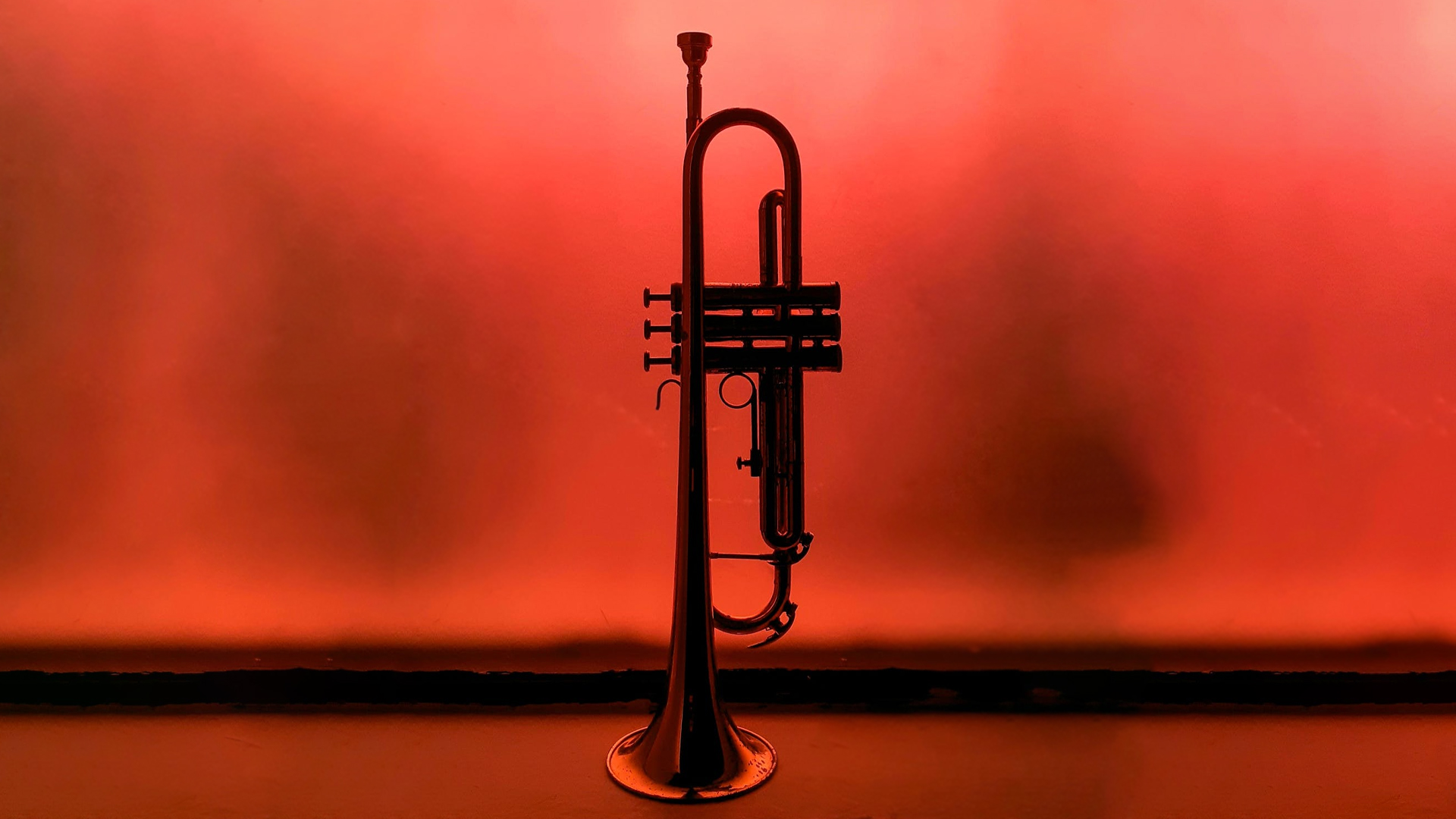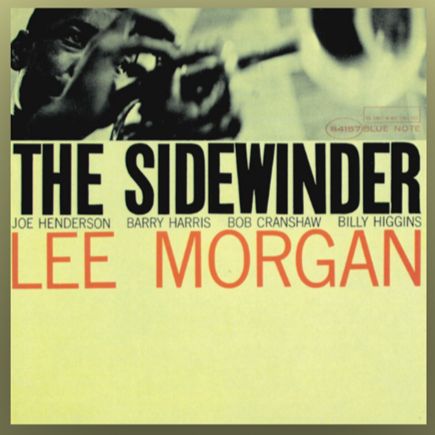Lee Morgan, le feu du hard bop
Figure emblématique du hard bop, Lee Morgan incarne l’une des voix les plus vibrantes et intenses de la trompette jazz des années 1950 et 1960. Né à Philadelphie, il s’impose très jeune comme un prodige de l’instrument. À dix-huit ans à peine, il rejoint l’orchestre de Dizzy Gillespie, dont l’influence sera déterminante. Morgan y apprend la rigueur rythmique, la virtuosité et la puissance expressive du bebop, tout en affirmant un ton personnel, plus lyrique, plus incisif.
Rapidement, il devient l’un des piliers du label Blue Note, où il grave une série d’albums devenus essentiels à la définition du hard bop. Ce style, héritier du bebop mais ancré dans le blues, la soul et le gospel, exprime une énergie urbaine et une profondeur émotionnelle nouvelles. Lee Morgan s’y distingue par un jeu flamboyant, à la fois clair et nerveux, mêlant précision technique et tension dramatique.
Son œuvre majeure, The Sidewinder (1963), illustre parfaitement cette synthèse. Le titre éponyme, avec son groove entraînant et son thème contagieux, devient un succès inattendu, atteignant les classements pop et propulsant le jazz instrumental sur les ondes radiophoniques américaines. Derrière ce triomphe se cache un compositeur d’une grande subtilité: Lee Morgan y déploie un sens de la mélodie simple mais irrésistible, allié à une architecture harmonique d’une rare élégance. L’album ouvre la voie à toute une génération de musiciens Blue Note, qui s’inspireront de ce modèle de modernité accessible.
Avant et après The Sidewinder, Lee Morgan signe plusieurs disques marquants, parmi lesquels Search for the New Land (1964), d’une profondeur presque spirituelle, et Cornbread (1965), où l’équilibre entre écriture et improvisation atteint une maturité exemplaire. Il collabore également avec Art Blakey et ses Jazz Messengers, dont il devient une figure centrale. Au sein de cette formation, il affine son style, plus narratif, plus dense, souvent empreint d’une intensité dramatique rare.
La trajectoire de Lee Morgan est cependant aussi fulgurante que tragique. À seulement trente-trois ans, il mourut assassiné par sa femme: un soir de concert, elle le trouva en compagnie d’une autre femme, une dispute s’ensuivit et elle le tua.
Lee Morgan, el fuego del hard bop
Figura emblemática del hard bop, Lee Morgan encarna una de las voces más vibrantes e intensas de la trompeta jazz de las décadas de 1950 y 1960. Nacido en Filadelfia, se impuso desde muy joven como un prodigio del instrumento. Con apenas dieciocho años, se unió a la orquesta de Dizzy Gillespie, cuya influencia resultó decisiva. En ella, Morgan aprendió la precisión rítmica, la virtuosidad y la fuerza expresiva del bebop, al tiempo que afirmaba un tono personal, más lírico y más incisivo.
Rápidamente se convirtió en uno de los pilares del sello Blue Note, donde grabó una serie de álbumes fundamentales para definir el hard bop. Este estilo, heredero del bebop pero arraigado en el blues, el soul y el gospel, expresa una energía urbana y una profundidad emocional nuevas. Morgan destacó por un toque ardiente, claro y enérgico, que combinaba precisión técnica con una intensa tensión dramática.
Su obra maestra, The Sidewinder (1963), ilustra a la perfección esa síntesis. El tema principal, con su groove contagioso y su melodía hipnótica, se convirtió en un éxito inesperado, alcanzando las listas de música popular y llevando el jazz instrumental a las emisoras de radio estadounidenses. Detrás de ese triunfo se revela un compositor de gran sutileza: Morgan desplegó un sentido de la melodía simple pero irresistible, unido a una arquitectura armónica de extraordinaria elegancia. El álbum abrió el camino a toda una generación de músicos de Blue Note, que se inspirarían en ese modelo de modernidad accesible.
Antes y después de The Sidewinder, Morgan firmó varios discos notables, entre ellos Search for the New Land (1964), de una profundidad casi espiritual, y Cornbread (1965), donde el equilibrio entre escritura e improvisación alcanza una madurez ejemplar. También colaboró con Art Blakey y sus Jazz Messengers, de los que se convirtió en figura central. En esa formación perfeccionó su estilo, más narrativo, más denso, a menudo cargado de una rara intensidad dramática.
Sin embargo, la trayectoria de Lee Morgan fue tan fulgurante como trágica. A los treinta y tres años, fue asesinado por su esposa tras una discusión durante un concierto, poniendo fin de forma brutal a una carrera marcada por el talento, la pasión y la vulnerabilidad.
Lee Morgan, il fuoco dell’hard bop
Figura emblematica dell’hard bop, Lee Morgan rappresenta una delle voci più vibranti e intense della tromba jazz degli anni Cinquanta e Sessanta. Nato a Filadelfia, si afferma giovanissimo come un prodigio dello strumento. A soli diciotto anni entra nell’orchestra di Dizzy Gillespie, la cui influenza sarà determinante. Con lui, Morgan apprende la precisione ritmica, la virtuosità e la potenza espressiva del bebop, sviluppando al tempo stesso un tono personale, più lirico e incisivo.
Ben presto diventa uno dei pilastri dell’etichetta Blue Note, per la quale incide una serie di album fondamentali nella definizione dell’hard bop. Questo stile, erede del bebop ma radicato nel blues, nel soul e nel gospel, esprime un’energia urbana e una profondità emotiva nuove. Morgan si distingue per un fraseggio ardente, al tempo stesso chiaro e nervoso, che unisce precisione tecnica e tensione drammatica.
La sua opera più celebre, The Sidewinder (1963), illustra perfettamente questa sintesi. Il brano omonimo, con il suo groove trascinante e il tema immediatamente riconoscibile, diventa un successo inatteso, entrando nelle classifiche pop e portando il jazz strumentale sulle radio americane. Dietro quel trionfo si cela un compositore di grande raffinatezza: Morgan vi esprime un senso melodico semplice ma irresistibile, unito a un’architettura armonica di rara eleganza. L’album apre la strada a un’intera generazione di musicisti Blue Note, ispirati da quel modello di modernità accessibile.
Prima e dopo The Sidewinder, Morgan realizza diversi dischi significativi, tra cui Search for the New Land (1964), di una profondità quasi spirituale, e Cornbread (1965), dove l’equilibrio tra scrittura e improvvisazione raggiunge una maturità esemplare. Collabora inoltre con Art Blakey e i suoi Jazz Messengers, di cui diventa una figura centrale. All’interno di questa formazione affina il suo stile, più narrativo e intenso, spesso pervaso da una drammaticità profonda.
La parabola di Lee Morgan è tuttavia tanto luminosa quanto tragica. A soli trentatré anni viene assassinato dalla moglie durante una lite avvenuta in un locale, una fine improvvisa che spezza il percorso di uno dei talenti più ardenti e appassionati del jazz moderno.
Lee Morgan, the fire of hard bop
A defining figure of hard bop, Lee Morgan embodies one of the most vibrant and intense voices of jazz trumpet in the 1950s and 1960s. Born in Philadelphia, he stood out early as a prodigy of the instrument. At just eighteen, he joined Dizzy Gillespie’s orchestra, whose influence proved decisive. There, Morgan absorbed the rhythmic precision, virtuosity, and expressive power of bebop while shaping his own voice—more lyrical, more incisive.
He soon became one of the cornerstones of the Blue Note label, where he recorded a series of albums that helped define the hard bop idiom. This style, rooted in bebop but infused with blues, soul, and gospel, expressed a new urban energy and emotional depth. Morgan’s playing was fiery yet lucid, combining technical precision with dramatic tension.
His masterpiece, The Sidewinder (1963), perfectly captures that synthesis. The title track, with its infectious groove and catchy melody, became an unexpected hit, breaking into the pop charts and bringing instrumental jazz to mainstream radio. Behind that triumph lay a composer of great subtlety: Morgan displayed a gift for simple yet irresistible melody, framed by a harmonic structure of rare elegance. The album paved the way for an entire generation of Blue Note artists inspired by this model of accessible modernity.
Before and after The Sidewinder, Morgan produced several landmark recordings, including Search for the New Land (1964), marked by a near-spiritual depth, and Cornbread (1965), where the balance between composition and improvisation reached exemplary maturity. He also collaborated with Art Blakey and his Jazz Messengers, becoming one of the ensemble’s central voices. Within that group, he refined a more narrative, denser style, often charged with a striking dramatic intensity.
Yet Morgan’s path was as brilliant as it was tragic. At just thirty-three, he was shot and killed by his wife during an argument at a club—an abrupt, devastating end to the life of one of jazz’s most passionate and incandescent voices.

Autres articles – Otros artículos – Altri articoli
Styles de jazz – Estilos de jazz – Stili di jazz – Jazz Styles
I Remember Clifford–24.03.1957–Lee MORGAN
Whisper Not–07.04-08.04.1957–Dizzy GILLESPIE
All The Things You Are–08.04.1957–Johnny GRIFFIN
Star Eyes–16.03.1958–Tina BROOKS
Bags’ Groove–21.04.1958–Hank MOBLEY
Come Rain Or Come Shine–30.10.1958–Art BLAKEY & THE JAZZ MESSENGERS
I Remember Clifford–22.11-17.12.1958–THE JAZZ MESSENGERS
A Night In Tunisia–14.08.1960–Art BLAKEY & THE JAZZ MESSENGERS

